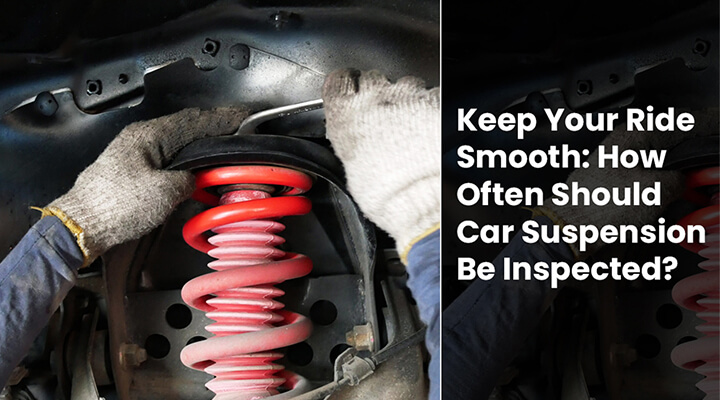Keep Your Ride Smooth: How Often Should Car Suspension Be Inspected?
Your car’s suspension system plays a critical role in ensuring a smooth and safe driving experience. It not only provides comfort by absorbing shocks from the road but also maintains tire contact with the road, which is essential for steering stability and braking. Given its importance, regular inspection and maintenance of the suspension system are crucial. This blog will guide you on how often you should inspect your car’s suspension to keep your ride smooth and safe.
Understanding the Car Suspension System
The suspension system comprises various components, including:
- Shock Absorbers: These dampen the impact of road irregularities.
- Struts: These are structural components that include a shock absorber and a coil spring.
- Springs: These support the vehicle’s weight and absorb large bumps.
- Control Arms: These connect the wheel hubs to the vehicle’s frame, allowing for controlled movement.
- Bushings and Bearings: These reduce friction between the suspension components.
Each of these components works together to provide stability, handling, and comfort.
Importance of Regular Suspension Inspections
Regular suspension inspections are essential for several reasons:
- Safety: A well-maintained suspension system ensures better handling and control, reducing the risk of accidents.
- Comfort: A functional suspension system absorbs road bumps, providing a smoother ride.
- Tire Wear: Properly functioning suspension prevents uneven tire wear, extending the life of your tires.
- Cost Savings: Early detection of suspension issues can prevent more severe damage and costly repairs.
Recommended Frequency for Suspension Inspections
- Routine Maintenance Checks:
- Every 12,000 to 15,000 Miles: It’s generally recommended to have your suspension system inspected at every oil change or at least every 12,000 to 15,000 miles. During these checks, mechanics can identify any early signs of wear and tear.
- Annual Inspection:
- Once a Year: An annual comprehensive inspection of the suspension system should be part of your vehicle’s maintenance schedule. This helps in catching issues that might not be apparent during regular maintenance checks.
- When Symptoms Appear:
- Immediate Inspection: If you notice any of the following signs, it’s essential to have your suspension inspected immediately:
- Unusual Noises: Clunking or squeaking sounds when driving over bumps.
- Poor Handling: Difficulty in steering or the vehicle pulling to one side.
- Uneven Tire Wear: Tires wearing out more on one side.
- Rough Ride: Excessive bouncing or a generally rough ride.
- Leaning: The vehicle leaning to one side when parked or in motion.
- Immediate Inspection: If you notice any of the following signs, it’s essential to have your suspension inspected immediately:
Factors Influencing Suspension Wear
- Driving Conditions:
- Road Quality: Frequent driving on rough or uneven roads accelerates suspension wear.
- Weather: Extreme weather conditions, such as excessive heat or cold, can affect suspension components.
- Driving Habits:
- Aggressive Driving: Hard braking, sharp turns, and high-speed driving can strain the suspension.
- Load: Carrying heavy loads regularly can put extra pressure on the suspension system.
- Vehicle Age and Mileage:
- Older Vehicles: Older vehicles or those with high mileage are more likely to have worn suspension components.
Tips for Maintaining Your Suspension System
- Regular Inspections:
- Stick to the recommended inspection schedule and address any issues promptly.
- Tire Maintenance:
- Regularly check and maintain tire pressure and alignment to reduce suspension strain.
- Smooth Driving:
- Avoid aggressive driving habits and reduce speed on rough roads to minimize suspension wear.
- Professional Servicing:
- Ensure that any suspension repairs or replacements are carried out by qualified professionals using quality parts.
Conclusion
Regular inspection and maintenance of your car’s suspension system are vital for safety, comfort, and overall vehicle performance. In general, have your suspension checked every 12,000 to 15,000 miles, during annual comprehensive inspections, and immediately if any symptoms of wear appear. By staying proactive with suspension maintenance, you can ensure a smoother and safer ride, extend the life of your tires, and avoid costly repairs.
For expert suspension inspections and maintenance services in Qatar, visit Qservices. Our experienced technicians are dedicated to keeping your vehicle in top condition, ensuring a smooth and comfortable driving experience.

